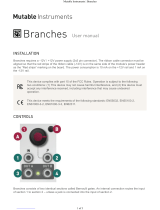Page is loading ...

Blinds
Quad VC-polarizer
About Blinds
Blinds is a 4-channel voltage-controlled signal polarizer.
Each channel consists of a polarizer circuit, also known
as a four-quadrant multiplier. This circuit acts like a
VCA, except that a negative control voltage will cause the
output signal to be inverted, instead of being silenced.
Blinds’ outputs are daisy-chained, allowing adjacent
groups of 2, 3, or all 4 channels, to be mixed together.
Blinds requires a -12V / +12V power supply (2x5 pin
connector). The red stripe of the ribbon cable (-12V side)
must be oriented on the same side as the “Red stripe”
marking on the board. The module draws 70mA from the
-12V rail and 70mA from the +12V rail. Current con-
sumption can reach 90mA on either channel depending
on the color and brightness of the LEDs.
Online manual and help
The full manual can be found online at
mutable-instruments.net/modules/blinds/manual
For help and discussions, head to
mutable-instruments.net/forum
MOD IN IN
OUT
Previous
channels

Controls
A. Channel polarity and gain. At 12 o’clock, the channel
is muted. Turn clockwise to amplify, turn counter-clock-
wise to amplify and invert.
B. Modulation attenuverter. Adjusts the amount and
polarity of modulation from the modulation input (2), i.e.
how much, and in which direction, the channel polarity
and gain will wiggle around the central value set by A.
Inputs and Outputs
1. Signal input. Blinds’ inputs are DC-coupled and
accept both audio and CV signals. This input receives
+5V when no patch cable is inserted.
2. Modulation input. This input is also DC-coupled.
When audio-rate signals are present on both the signal
and modulation input, Blinds works as a ring-modulator.
3. Signal output. When no patch cable is plugged into an
output, the signal from this channel is routed to the next
channel. For example, when no patch cable is patched
into output 1, output 2 will contain the sum of channel 2
and channel 1. If nothing is patched into outputs 1, 2 and
3, then output 4 will contain the sum of all four chan-
nels.
4. Gain and polarity indicator. The color corresponds to
the polarity (green = positive, red = negative), the bright-
ness to the gain.
5. Output level and polarity indicator.
A
B
1
2
3
4
5
/















